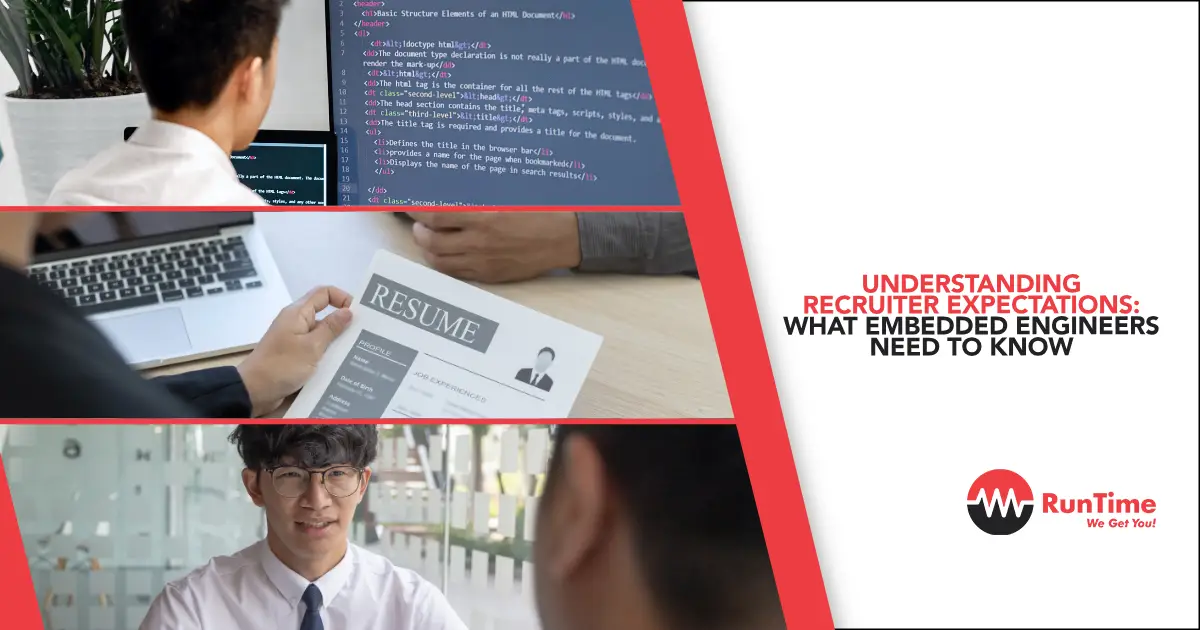In the competitive field of embedded engineering, meeting recruiter expectations is crucial for landing desirable positions. Embedded engineers must possess not only technical expertise but also a keen understanding of what recruiters seek. This introduction delves into the essential aspects that embedded engineers need to know to stand out in the eyes of recruiters.
From mastering key programming languages and tools to showcasing problem-solving skills and a strong grasp of hardware design, this guide will explore the core competencies that recruiters often prioritize. Moreover, we will delve into the importance of soft skills such as communication, teamwork, and adaptability in making a lasting impression on recruiters.
By the end of this discussion, embedded engineers will gain valuable insights into aligning their skills and experiences with recruiter expectations, ultimately enhancing their prospects in the competitive job market.
The Recruitment Process for Embedded Engineers
In the fast-evolving field of embedded engineering, recruiting top talent is crucial for companies to maintain their competitiveness and drive innovation. To attract and retain the best candidates, recruiters need to implement a strategic and customized approach to the recruitment process. The context provided offers valuable insights that can serve as a blueprint for recruiters looking to optimize their hiring strategies.
One of the key aspects emphasized is the importance of refining job specifications to highlight essential skills, relevant experience, and the potential impact a candidate can bring to the organization. This tailored approach not only ensures that new hires meet the technical requirements but also that they align with the company’s culture, vision, and ongoing projects, thereby driving significant results.
Collaborating with specialized recruitment agencies, such as the example of RunTime, can be immensely advantageous for recruiters. These agencies possess the expertise to identify top candidates who are not only technically proficient but also culturally compatible with the organization. RunTime’s integrated approach, which includes content marketing, leveraging social networks, utilizing job boards, and leveraging a proprietary database, streamlines the candidate sourcing process, enabling the efficient identification of qualified individuals.
Furthermore, providing a seamless recruitment experience characterized by exceptional service is paramount in both attracting and retaining talent. Recruiters should offer comprehensive support throughout the hiring journey, from pre-interview coaching to salary negotiations, demonstrating integrity, agility, and professionalism at every stage.
Establishing enduring client relationships and collaborating with expert teams that possess a deep understanding of embedded engineering hiring requirements are pivotal for successful recruitment outcomes. Recruiters specializing in diverse industries such as medical, transportation, and industrial automation, as well as various technologies like Ethernet, audio, video, and platforms including ARM, MIPS, and PowerPC, can tailor their recruitment strategies to effectively meet the unique demands of each role.
By embracing tailored hiring solutions, fine-tuning job specifications, leveraging multiple recruitment channels, providing exceptional service, nurturing long-term client partnerships, and partnering with expert teams, recruiters can elevate their recruitment process for embedded engineers and secure top talent effectively.
Key Skills and Technologies in Embedded Engineering
Essential Skills and Experience for Embedded Engineers:
- Proficiency in programming languages such as C, C++, and Assembly is fundamental for embedded engineers to develop efficient and optimized code for embedded systems.
- A strong understanding of microcontrollers and microprocessors is crucial as they form the backbone of embedded systems, controlling their operation and functionality.
- Knowledge of embedded systems design and development encompasses the ability to architect, implement, and test embedded solutions for various applications.
- Familiarity with communication protocols like SPI, I2C, and UART is essential for enabling seamless data transfer between different components within embedded systems.
- Working with sensors and actuators requires expertise in interfacing these devices with microcontrollers to gather and act upon real-world data.
- Experience in low-level hardware interaction and driver development is vital for optimizing hardware utilization and ensuring proper functionality of peripherals.
- Understanding signal processing algorithms for real-time applications is necessary for tasks like filtering, noise reduction, and data analysis in embedded systems.
Overview of Technologies and Roles in Embedded Engineering:
- Real-time operating systems (RTOS) play a critical role in deterministic systems by providing timely response to events and tasks in embedded applications.
- Knowledge of hardware description languages like VHDL or Verilog is beneficial for engineers involved in FPGA programming for custom hardware implementations.
- System on Chip (SoC) architectures are increasingly utilized in embedded systems for integrating multiple functions on a single chip, streamlining design and improving efficiency.
- Proficiency in using oscilloscopes, logic analyzers, and other debugging tools is essential for hardware validation and troubleshooting in embedded hardware development.
- Understanding wireless communication protocols such as Bluetooth, Zigbee, and LoRa is important for implementing connectivity solutions in embedded systems.
Common Roles in Embedded Engineering:
- Embedded Software Engineer: Responsible for developing and optimizing software to run on embedded systems, ensuring functionality and performance.
- Hardware Engineer: Focuses on designing and testing hardware components like circuit boards and sensors used in embedded devices.
- Embedded Systems Architect: Defines the system architecture and oversees the integration of software and hardware components to meet project requirements.
- Firmware Engineer: Specializes in creating and maintaining firmware, the low-level software that provides control for hardware components in embedded systems.
- IoT Embedded Engineer: Works on integrating IoT technologies into embedded systems to enable smart applications and connectivity.
Trends Impacting Embedded Engineering Recruitment:
- Edge computing is revolutionizing embedded systems by processing data closer to the source, reducing latency and bandwidth usage in IoT applications.
- Integration of AI and ML algorithms on edge devices enables real-time decision-making and data processing, enhancing the capabilities of embedded systems.
- Emphasis on cybersecurity practices is growing to protect embedded devices from potential threats, ensuring data integrity and system security.
- Adoption of Agile methodologies in embedded software development accelerates product iterations, enabling faster deployment and response to market demands.
- Energy harvesting techniques are gaining traction for creating self-powered embedded devices, reducing reliance on external power sources and enhancing sustainability.
In the rapidly evolving field of embedded engineering, professionals must stay updated with the latest technologies, tools, and trends to remain competitive and drive innovation. Continuous learning, hands-on experience, and a passion for problem-solving are key to succeeding in this dynamic and exciting industry.
RunTime’s Expertise in Embedded Engineering Recruitment
RunTime’s expertise in embedded engineering recruitment is unparalleled in the industry, setting them apart with their unique approach and proven success. By combining technical proficiency, customized hiring solutions, and innovative candidate sourcing strategies, RunTime consistently delivers exceptional outcomes for both clients and candidates. Understanding the specific requirements of each job role and the evolving needs of the industry, RunTime meticulously refines job specifications to emphasize crucial skills, relevant experience, and potential impact, ensuring precise matches that drive success. Leveraging a multi-faceted recruitment strategy encompassing content marketing, social networks, job boards, and an exclusive database, RunTime swiftly identifies and engages top-tier candidates, streamlining the hiring process for efficiency and accuracy. Moreover, RunTime’s commitment to providing comprehensive services, including pre-interview coaching and adept salary negotiations, further solidifies their position as a trusted partner in facilitating ideal connections between talent and opportunities. With a strong foundation built on enduring client partnerships and deep-rooted industry knowledge, RunTime has successfully placed over 123 candidates, boasting an impressive candidate retention rate of 79% that underscores their effectiveness and reliability in the specialized realm of embedded engineering recruitment.
Holistic Approach to Recruitment
RunTime’s success in embedded engineering recruitment can be attributed to their holistic approach that goes beyond traditional hiring practices. One key aspect that sets RunTime apart is their proactive engagement with candidates. RunTime not only matches skills and experiences but also focuses on cultural fit and long-term career goals, ensuring that candidates are not only placed in roles but thrive in them. This personalized approach enhances job satisfaction and reduces turnover rates, benefiting both the candidates and the hiring companies.
Utilization of Cutting-Edge Technology
Additionally, RunTime’s utilization of cutting-edge technology in their recruitment processes gives them a competitive edge. By leveraging data analytics, artificial intelligence, and machine learning algorithms, RunTime can identify trends, predict candidate success, and continuously improve their recruitment strategies. This tech-driven approach enables RunTime to stay ahead of the curve in a rapidly evolving industry landscape, providing their clients with the most qualified candidates efficiently and effectively.
Dedication to Ongoing Learning and Development
Furthermore, RunTime’s dedication to ongoing learning and development ensures that their team remains at the forefront of industry advancements. By staying informed about emerging technologies, market trends, and best practices in embedded engineering, RunTime can offer innovative solutions to both clients and candidates, further solidifying their position as a trusted partner in the recruitment process.
Navigating the Hiring Process as an Embedded Engineer
Mastering Technical Interviews: Standing Out as an Embedded Engineer
In the competitive field of embedded engineering, technical interviews are a crucial aspect of the hiring process. To stand out to recruiters and hiring managers, it is essential to showcase your technical skills and problem-solving abilities. Here are some tips to help you prepare:.
- Brush up on your technical knowledge: Review key concepts in embedded systems, microcontrollers, and programming languages commonly used in the industry.
- Practice coding: Be prepared to tackle coding challenges and demonstrate your ability to write clean, efficient code.
- Showcase your projects: Highlight any relevant projects you have worked on, emphasizing your contributions and the impact of your work.
Negotiating Your Salary and Benefits Package
Once you have successfully navigated the technical interviews and received a job offer, the next step is negotiating your salary and benefits package. Here are some insights to help you secure a competitive compensation package:.
- Research industry standards: Understand the typical salary range for embedded engineers with your level of experience and expertise.
- Highlight your value: Clearly communicate the unique skills and experiences that you bring to the table, emphasizing how you can contribute to the success of the company.
- Consider the full package: In addition to salary, consider other benefits such as healthcare, retirement plans, and opportunities for professional development.
Building Professional Relationships with Recruiters
Establishing strong relationships with recruiters can be beneficial throughout your career as an embedded engineer. Here are some tips for building and maintaining positive relationships with recruiters:.
- Be responsive and professional: Respond promptly to emails and calls from recruiters, and always maintain a professional demeanor.
- Keep them updated: Inform recruiters of any changes in your job status, skills, or preferences so they can better assist you in finding opportunities.
- Network proactively: Attend industry events, conferences, and networking sessions to expand your professional network and connect with recruiters from top companies.
By following these tips and insights, you can navigate the hiring process more effectively and position yourself for long-term success in the field of embedded engineering.
Industry Specializations and Recruitment Challenges
In the ever-evolving landscape of engineering and technology, specialized sectors like embedded engineering require a unique approach to recruitment that goes beyond traditional hiring practices. RunTime , a leading recruitment agency, has carved a niche for itself by focusing on industry-specific recruitment needs within embedded engineering, offering tailored solutions that align with company culture and industry requirements. By delving deep into the intricacies of job specifications and emphasizing essential skills, relevant experience, and potential impact,. RunTime Ensures that every hire is not just a placement but a strategic addition to the team.
One of the standout features of. RunTime ‘s recruitment strategy is its multifaceted sourcing approach. Leveraging a mix of content marketing, social networks, job boards, and their extensive candidate database,. RunTime Effectively navigates the challenges of talent acquisition in specialized sectors. This comprehensive sourcing strategy enables them to swiftly identify and present top-tier candidates who are not only technically proficient but also culturally aligned with the organizations they serve.
However, the specialized nature of industries like medical, transport, industrial automation, and IoT presents a unique set of recruitment challenges, primarily stemming from the scarcity of professionals with the requisite technical expertise. RunTime ‘s deep-rooted industry knowledge allows them to tackle these challenges head-on. By honing their expertise across a spectrum of roles in embedded engineering and diverse technological domains,. RunTime Has positioned itself as a strategic partner for companies seeking exceptional talent in highly specialized fields.
Moreover,. RunTime ‘s commitment to nurturing long-term client relationships underscores their dedication to sustainable recruitment solutions. By proactively engaging with clients in specialized sectors,. RunTime Not only anticipates future hiring needs but also customizes their recruitment strategies to meet evolving demands effectively. This forward-thinking approach not only streamlines the hiring process but also enhances the success rate of candidate placements, ensuring a mutually beneficial match between talent and organization.
RunTime ‘s fusion of industry specialization, customized recruitment methodologies, and unwavering client partnerships cements their reputation as a premier player in engineering recruitment for specialized sectors. Their relentless pursuit of understanding client dynamics and candidate suitability places them at the forefront of the competitive recruitment landscape, making them the preferred choice for companies seeking top-tier talent in embedded engineering and related fields.
The Future of Embedded Engineering Recruitment
Emerging Technologies Shaping the Future of Embedded Engineering Recruitment
In recent years, emerging technologies like artificial intelligence, machine learning, and the Internet of Things have significantly impacted the field of embedded engineering recruitment. Companies are now looking for candidates with a diverse skill set that includes not only traditional engineering knowledge but also expertise in these cutting-edge technologies. The integration of these technologies into embedded systems has led to a demand for engineers who can design and implement innovative solutions that leverage AI, ML, and IoT to enhance product performance and user experience.
Predictions on How Recruitment Practices in the Field Might Evolve
As technology continues to advance, recruitment practices in the embedded engineering field are expected to evolve as well. One prediction is an increased focus on remote work capabilities, as companies embrace the flexibility and global talent pool that remote work offers. Additionally, virtual reality and augmented reality are likely to play a more prominent role in the recruitment process, providing immersive experiences for both candidates and employers. Furthermore, the rise of collaborative tools and platforms will facilitate virtual collaboration among distributed teams, making it easier for companies to access talent from around the world.
Strategies for Staying Competitive in the Evolving Embedded Engineering Job Market
To stay competitive in the evolving embedded engineering job market, professionals need to continuously upskill and adapt to new technologies. Networking and building a strong online presence through platforms like LinkedIn can also enhance job prospects. Moreover, keeping up with industry trends and being open to new challenges are key strategies for success in a rapidly changing field. Embracing lifelong learning through online courses, workshops, and certifications can help engineers stay ahead of the curve and demonstrate their commitment to professional development. Additionally, cultivating soft skills such as communication, problem-solving, and creativity can set candidates apart in a competitive job market where technical expertise alone may not suffice.
The Impact of Remote Work on Embedded Engineering Recruitment
The shift to remote work has not only influenced how companies operate but has also transformed the recruitment landscape. With remote work becoming more prevalent, candidates now have access to opportunities beyond their geographical location. Employers, on the other hand, can tap into a global talent pool, allowing them to find the best fit for their embedded engineering roles. This trend has led to a reevaluation of traditional recruitment processes, with many companies opting for virtual interviews, online technical assessments, and collaborative coding challenges to assess candidates’ skills and compatibility with remote work setups.
The Role of Industry 4.0 in Reshaping Embedded Engineering Careers
Industry 4.0, characterized by the integration of cyber-physical systems, the Internet of Things, and cloud computing in manufacturing, is not only revolutionizing production processes but also influencing the skill sets required in embedded engineering roles. Engineers now need to be proficient in not just hardware design and firmware development but also in areas such as data analytics, cybersecurity, and connectivity protocols. The ability to design smart, interconnected systems that can communicate and operate autonomously is becoming increasingly valuable in the era of Industry 4.0. As a result, professionals in the embedded engineering field are encouraged to broaden their expertise beyond traditional boundaries and explore interdisciplinary knowledge to adapt to the changing demands of the industry.
Navigating the Impact of AI and Automation on Embedded Engineering Recruitment
The rise of artificial intelligence and automation is reshaping the nature of work across various industries, including embedded engineering. While AI-powered tools and automated processes have streamlined many aspects of product development and testing, they have also raised concerns about the future of certain job roles. In the field of embedded engineering, professionals are now required to collaborate with AI systems, optimize algorithms, and ensure seamless integration of intelligent technologies into embedded systems. This shift emphasizes the importance of acquiring skills in AI, machine learning, and algorithm design to remain relevant in a landscape where human-machine collaboration is becoming increasingly prevalent. By embracing AI and automation as enablers rather than threats, embedded engineers can leverage these technologies to enhance their problem-solving capabilities, innovate more efficiently, and deliver cutting-edge solutions that meet the evolving needs of the industry.
Conclusion
Understanding recruiter expectations is crucial for embedded engineers looking to advance in their careers. By focusing on. technical skills ,. industry knowledge , and. communication abilities , engineers can position themselves as strong candidates in the competitive job market. It is essential for embedded engineers to continuously adapt and develop their skills to meet evolving industry demands and stand out to recruiters seeking top talent in the field.









